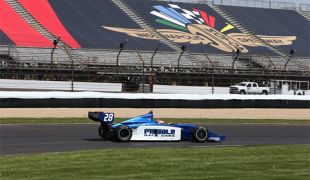Read: A race I’ll never forget
Indy Lights, Indy Lights bloggers, Lloyd Read, Mazda Road to Indy — By Lloyd Read on May 16, 2014 2:56 pm When I heard that we would be racing on the Indianapolis F1 circuit, I got the same feeling that I experienced last year when I was in Pro Mazda and the Circuit of the Americas event was announced. The newly designed road course at the iconic Indianapolis Motor Speedway was shaping up to be a race that had everything. The long straights into slow corners would provide more passing than any circuit on the 2013 calendar had previously offered. This was the weekend that I had been preparing for since fall of 2013.
When I heard that we would be racing on the Indianapolis F1 circuit, I got the same feeling that I experienced last year when I was in Pro Mazda and the Circuit of the Americas event was announced. The newly designed road course at the iconic Indianapolis Motor Speedway was shaping up to be a race that had everything. The long straights into slow corners would provide more passing than any circuit on the 2013 calendar had previously offered. This was the weekend that I had been preparing for since fall of 2013.
Fortunately, IndyCar was the only series racing this weekend, so we did not have to share the track with sports cars. We were given a test day and even a warmup session on Saturday morning!
Since this was a new circuit that was different than any other circuit we had run on, getting the setup right was important. After the first practice it was clear that we needed to trim out the car in order to maximize straight line speed and decrease lap time.
This, however, was a small problem in the grand scheme of things.
From the first out lap I knew something was wrong with the gearbox. I could up shift, but down shifts were nearly impossible. I pitted immediately and explained the problem, but there was no visible sign of a problem on the gearbox. I ended up driving the rest of the session struggling to downshift with many neutrals. After the session the problem was diagnosed as an incorrectly fitted shift linkage cable. Recalibrating this fixed the issue for session 2.
In session 2 I got to unleash the car and start to figure out the Indy GP circuit. Our top gears were spot on for the downforce levels, but the short gears were still an issue. I was shifting in the middle of corners, which was killing my momentum and hurting my lap time.
As the session went on I drove the car to the grip level it had and we found that it needed to have a spring package that was much different than what my engineer felt would work due to the extremely flat and smooth surface. All in all, it was a decent session that would put us close to the pack and with a shot for good qualifying position.
Qualifying took place on Friday morning, and we were ready to rock. We had two sets of tires ready to go, and I was sure that I could squeeze an extra few tenths out of the car to put in a good time.
Problems would arise on my outlap, though: when I tried to brake for turn 7, my foot went to the floor.
I managed to pump the pedal enough to avoid the tire wall and quickly rushed to pit lane. The mechanics took a look at everything and said it looked okay and that if I felt comfortable that I should go back out. This was the Indy GP, and I was not going to quit.
I went back out, and the same thing happened again. The more laps I ran, the more I found that if I hit a curb the pedal went soft and would require me to pump the pedal to regain pressure in the braking system. I did this on every single lap on the back straight and front straight and avoided using the curbs everywhere else in order to save the brakes. Not the most ideal situation, but I did what I had to do.
As were rolling out onto pit lane for the first race, the heavens opened and it began spitting down. I was cheering because I love racing in the rain. It takes incredible mental strength along with an extremely soft race car to find the hidden grip on the circuit and not spin off.
As I was getting buckled in the rain subsided but had watered the track enough to make it a wet race. The five minutes to go board flashed up and I was ready, but I couldn’t help but notice the mad scramble by mechanics and the fact that I was still sitting on jack stands with no wheels on my car.
The clock was ticking down, and I could see my mechanics running down pit lane each with a wet tire in hand. Just after the last wheel was put on I heard, “Drivers, start your engines.” I fired up the old V8 and was on my way.
On the pace lap, however, something didn’t feel right with the braking system. I asked my engineer if they had touched the brake bias in between sessions and he said no. I quickly began to turn the brake bias to balance everything out, which took a lap but was ready to start the race.
We took the green flag and raced down to turn 1. As we got to turn 1 I knew that there was something very different about the other cars compared to mine. Everyone was using the curbs and it was not affecting their cars one bit. Every time I tried to use the curbs I would have massive oversteer ruining my exit. I followed the pack through turns 1, 2, 3, 4, and was struggling horribly. My car was flat sliding everywhere. It felt as if it had snowed instead of rained.
I hung on to the car, and as the track dried out it got better and better. With five laps to go I could see pieces of rubber that were golf ball sized chunks flying off the front tires. I knew that at any moment these tires were going to let go. Luckily, I made to the finish.
When I stopped I could see that the treaded rain tire was a slick, down to the cords with no meat left. After the race I told my engineer how slick the car was, and he said it was probably due to the ultra stiff dry setup we had on the car. Fortunately, we had a second race on Saturday that could provide some redemption.
*
NEXT PAGE: Lloyd Read’s report from race 2 of Indy Lights at the Grand Prix of Indianapolis
Pages: 1 2








